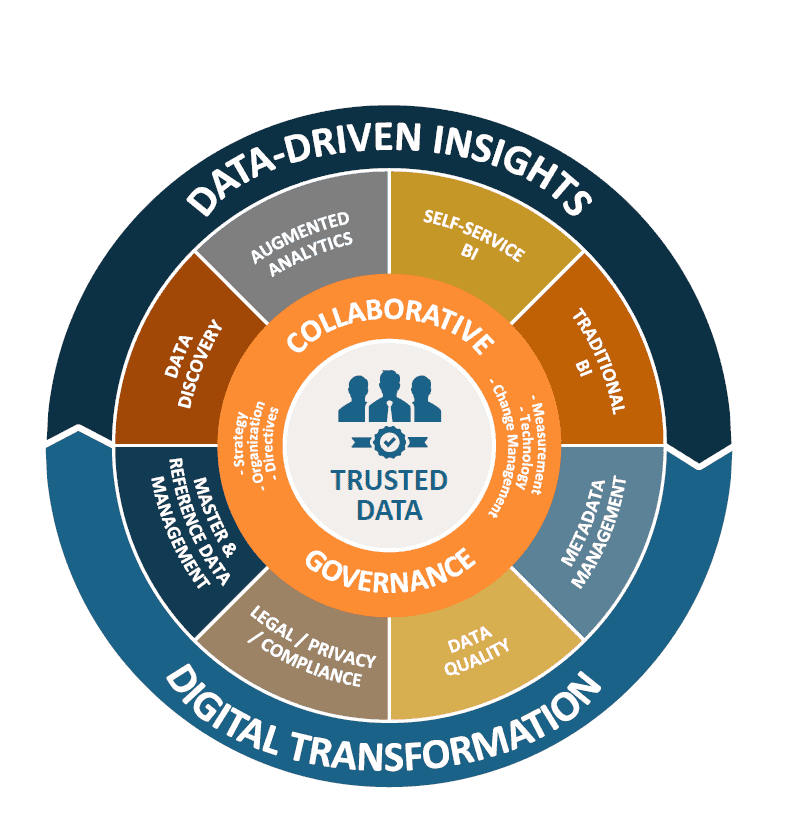How to Prepare Your Business For Digital Transformation
Digital transformation is a great way to strengthen and update your business - if you're ready for it! Learn more in our beginner's guide.

Digital transformation has become an essential part of modern businesses in today's world. By embracing new technologies and adapting to a digital-first environment, companies can improve efficiency, unlock new opportunities, and stay ahead of the competition. In this guide, we'll outline the basics of digital transformation and give you tips on how to make it successful.
Defining
Digital transformation is leveraging digital technologies to fundamentally change or improve how businesses operate and deliver value to customers. It involves integrating technology into all aspects of an organization, leading to a shift in culture, processes, and strategies to better adapt to the rapidly changing digital landscape. The goal of digital transformation is to improve efficiency, enhance customer experiences, and enable new business models, driving growth and competitiveness. Digital transformation can encompass various aspects, including:
- Business Models: Reimagining or creating new business models that leverage digital technologies to generate revenue, reach new markets, or deliver innovative products and services to customers.
- Customer Experience: Enhancing customer interactions and experiences using digital channels, data analytics, and personalization to understand better and meet customer needs.
- Operational Processes: Streamlining and automating internal processes to improve efficiency, reduce costs, and enable faster decision-making.
- Workplace Culture: Fostering a digital-first culture that encourages collaboration, innovation, and continuous learning, ensuring employees have the necessary skills and mindset to thrive in a digital environment.
- Technology Integration: Adopting and integrating digital technologies such as cloud computing, artificial intelligence (AI), Internet of Things (IoT), big data analytics, and cybersecurity to support and enable the organization's digital transformation journey.
- Data and Analytics: Leveraging data and analytics to gain insights, drive decision-making, and optimize business processes, as well as to identify new opportunities and trends.
- Security and Compliance: Ensuring data privacy and security while maintaining regulatory compliance in an increasingly digital and interconnected world.
Digital transformation is not a one-time event but rather an ongoing process of adaptation and evolution. Therefore, organizations must continuously assess their digital maturity and adapt to the changing landscape to stay competitive and relevant. This often requires a shift in mindset, embracing a culture of innovation and adaptability, and investing in the right technologies and skillsets.

Drivers
Digital transformation drivers are the key factors that compel organizations to leverage digital technologies to fundamentally change or improve how they operate and deliver value to customers. These drivers can vary from industry to industry and organization to organization, but some common ones include:
- Changing Customer Expectations: Today's customers expect personalized, seamless, and convenient experiences across all channels. Companies must adapt their products and services to meet these demands, often requiring digital transformation to provide a better customer experience.
- Technological Advancements: Rapid advancements in digital technologies, such as cloud computing, AI, IoT, big data analytics, and mobile technologies, create new opportunities for businesses to innovate, optimize processes, and develop new revenue streams.
- Increased Competition: The digital age has reduced barriers to entry and allowed new players to enter the market, increasing competition in various industries. Organizations must leverage digital technologies to stay ahead of competitors and maintain their market position.
- Globalization: The growth of global markets and international trade has increased the need for organizations to adapt to different demands, customer preferences, and regulatory environments. Digital transformation can enable businesses to expand globally and respond to these challenges more effectively.
- Disruptive Business Models: Innovative companies are introducing new business models that leverage digital technologies to disrupt traditional industries, such as the sharing economy, subscription models, or direct-to-consumer approaches. Organizations must adapt to these changes to remain competitive.
- Need for Operational Efficiency: Companies face increasing pressure to reduce costs and improve productivity. Digital transformation can streamline processes, automate tasks, and enable data-driven decision-making, increasing operational efficiency.
- Data Explosion: The rapid growth of data generated by digital devices and systems presents opportunities for organizations to gain insights and make better-informed decisions. Companies need to invest in digital transformation to harness the full potential of this data and unlock new opportunities.
- Regulatory and Compliance Requirements: Digital transformation can help organizations better manage regulatory and compliance requirements by automating processes, improving data accuracy, and enabling real-time monitoring and reporting.
- Workforce Expectations: The modern workforce demands flexible, collaborative, and digital-first work environments. Companies must invest in digital transformation to attract and retain top talent and ensure employees have the necessary skills and tools to succeed in a digital world.
- Agility and Adaptability: In an increasingly dynamic and unpredictable business environment, organizations must be agile and adaptable to respond to changing circumstances quickly. Digital transformation can enable companies to pivot and adapt more rapidly, driving innovation and resilience.
Strategy
A digital transformation strategy is a comprehensive plan that outlines an organization's approach to leveraging digital technologies to improve its business processes, enhance customer experiences, and enable new business models. Developing a successful digital transformation strategy involves a series of steps that focus on setting clear objectives, assessing the organization's current state, identifying opportunities, and implementing the necessary changes.
Below are some of the crucial steps to building an effective digital transformation strategy:
- Define your objectives: Clearly outline your digital transformation goals and objectives, which may include improving customer experiences, optimizing operational processes, enhancing employee engagement, or creating new revenue streams. Ensure these objectives align with your organization's overall business strategy and vision.
- Assess your current state: Perform a thorough analysis of your organization's digital maturity, including your technology infrastructure, processes, workforce skills, and company culture. Identify gaps, challenges, or areas needing improvement to support your digital transformation objectives.
- Identify opportunities: Based on your assessment, identify key opportunities for digital transformation in your organization. These may include implementing new technologies, automating processes, integrating data sources, or adopting innovative business models. Consider the potential impact of these opportunities on your organization and prioritize them based on their strategic value.
- Develop a roadmap: Create a detailed roadmap for your digital transformation journey, outlining the specific initiatives, projects, and milestones needed to achieve your objectives. This roadmap should include timelines, resources, budget requirements, and potential risks and dependencies.
- Establish governance and leadership: Appoint a dedicated team or individual, such as a Chief Digital Officer (CDO), to lead your digital transformation efforts and ensure alignment across the organization. Establish a governance structure that enables effective decision-making, collaboration, and accountability.
- Build capabilities and skills: Invest in the necessary training, tools, and resources to help your employees develop the digital skills and expertise needed to support your digital transformation strategy. Foster a continuous learning, innovation, and adaptability culture to ensure your workforce can thrive in a digital environment.
- Implement and execute: Execute your digital transformation initiatives according to your roadmap, focusing on iterative, agile development and continuous improvement. Regularly monitor and measure your efforts' progress and impact to ensure they deliver the desired results and adjust your strategy as needed.
- Communicate and engage: Keep your employees, customers, and stakeholders informed about your digital transformation efforts and the value they bring to the organization. Foster a culture of transparency and collaboration, ensuring that everyone understands the importance of digital transformation and is engaged in the process.
- Evaluate and adapt: Continuously assess the success of your digital transformation strategy, evaluating the impact on your organization's performance, customer experiences, and competitive position. Be prepared to adapt and evolve your plan to respond to new challenges, opportunities, and market conditions.
By following these steps, organizations can create a comprehensive and effective digital transformation strategy that drives innovation, enhances customer experiences, and positions the business for long-term success in a rapidly changing digital landscape.

Analyze your Business Processes
The first step to successful digital transformation is to analyze your current business processes and understand how they work. Take an in-depth look at your customer relationships, production cycles, and administrative functions. Consider which parts of these processes can benefit from digitization or automation to reduce costs and allow for greater efficiency. Analyzing your current operations will help you identify areas where digital transformation can be applied most effectively.
Furthermore, it’s important to consider how digital technologies may impact other parts of your business. You’ll need to understand how introducing new technologies may increase productivity, reduce cost, and improve customer service. This could include researching the latest in automation and artificial intelligence, or exploring cloud services such as software-as-a-service. Asking questions about the potential impact of these technologies is the key to successful digital transformation. By taking an analytical approach to your business processes, you can identify which areas are best suited for digitization or automation and develop a strategy for success.

Set Goals and Objectives
Once you have an understanding of which areas of your business can be improved through digital transformation, you can begin to set goals and objectives for the process. Setting objectives helps to ensure that the transformation is focused on what will benefit the business most. When setting goals and objectives, it’s important to be realistic. Establish short-term goals that are concrete and achievable in order to measure progress toward your long-term objectives.
Additionally, be sure to involve key stakeholders and decision makers in setting goals and objectives so that everyone is clear on expectations. Your ultimate goal should be to create a strategy for digital transformation that will improve processes, increase efficiencies, and optimize resources. This will help you get the most out of your digital transformation efforts now and into the future.
Establish Digital Transformation Teams & Working Groups
To ensure that your digital transformation process is successful, it is important to establish cross-functional teams or working groups. By having a dedicated team of individuals from different departments within your organization who are all knowledgeable about the process, you will be better equipped to tackle each phase of the digital transformation and take advantage of any opportunities that arise. Team members can have shared responsibilities and act as key decision makers throughout the process.
Content and workflow teams, for example, should be set up to review the ongoing content requirements and workflows needed for the successful deployment of the transformation strategy. The cross-functional teams should also include members from various departments such as marketing, IT and operations in order to ensure that all stakeholders can capture their perspectives and insights related to digital transformation. Additionally, by appointing dedicated team members who will be responsible each step of the process, tasks can be handled more efficiently and staff resources are more effectively allocated.
Prepare for Emergent Technology & Industry Changes
In order to prepare for any potential technological and industry changes, it is important to stay up-to-date on emerging technology trends and be familiar with new competitive offerings. This will help equip your organization with the knowledge required to stay ahead of competitors and take advantage of technological developments. Additionally, having an understanding of changing industry dynamics can provide you with valuable insights into where digital transformation efforts should be focused.
By taking the time to research new digital technologies as well as industry trends, organizations can be better positioned to stay up-to-date on the latest advances and look for opportunities to use them. Training existing staff members and seeking out external consultants or partners with specialized knowledge of the industry may also provide a valuable source of insight and direction when attempting to implement digital transformation initiatives. With the right preparation, any organization can be primed for success in an ever-changing technological and competitive landscape.
Design Your Digital Experiences & Workflows Solutions
When planning for digital transformation, it is essential to design the digital experiences and workflows in such a way that they deliver what the customer wants. By rethinking processes from end-to-end and identifying ways to improve them, businesses can ensure their customers are receiving an efficient end-to-end experience. Additionally, businesses must consider the security and privacy requirements when creating these experiences, as well as any resources that will be required to implement them effectively.
Digital transformation can be expensive and time-consuming if not done with the customer’s needs in mind. It is therefore essential to involve end-users in the design process to ensure their feedback is captured. Drawing on customer feedback allows for a more meaningful digital experience that works for both sides. Experienced designers are also essential for creating desired experiences, as they can inform every step of product development. Businesses must also consider how best to communicate any upcoming changes to customers so that they don’t feel disconnected from the process. When designed correctly, businesses have an invaluable opportunity to transform their operations and create truly personalized digital experiences and workflows solutions that meet their customers’ expectations.
Transformational technologies
Transformational technologies are innovations that have a significant impact on industries, markets, and societies by fundamentally changing the way businesses operate and people live. These technologies often disrupt existing systems, create new opportunities, and drive rapid advancements across various domains. Some key transformational technologies include:
- Artificial Intelligence (AI): AI refers to the development of computer systems capable of performing tasks that typically require human intelligence, such as image recognition, natural language processing, and decision-making. AI has the potential to revolutionize industries by automating processes, enhancing decision-making, and enabling new products and services.
- Internet of Things (IoT): IoT is the interconnection of everyday objects and devices via the internet, enabling them to send and receive data. IoT can improve efficiency, enable remote monitoring and control, and provide real-time insights across various sectors, such as manufacturing, agriculture, and transportation.
- Cloud Computing: Cloud computing is the delivery of computing services (including software, storage, and processing power) over the internet, allowing businesses to access resources on-demand and scale their operations more efficiently. Cloud computing can reduce IT costs, improve collaboration, and enhance agility.
- Microservices: Microservices is a software development approach that breaks down an extensive application into smaller, independent, and loosely-coupled components or services. Each microservice focuses on a specific functionality that can be developed, deployed, and scaled independently.
- Blockchain: Blockchain is a decentralized and distributed ledger technology that enables secure, transparent, and tamper-proof record-keeping. Blockchain has the potential to disrupt industries such as finance, supply chain management, and healthcare by enabling more secure and efficient transactions and data sharing.
- 5G Technology: 5G is the fifth-generation mobile network technology that promises faster speeds, lower latency, and increased connectivity compared to previous generations. 5G can enable new applications and services in areas like IoT, autonomous vehicles, and augmented reality.
- Big Data Analytics: Big data analytics refers to the process of analyzing large and complex datasets to discover patterns, trends, and insights that can inform decision-making. Big data analytics can transform industries by enabling data-driven decision-making, improving customer experiences, and optimizing processes.
- Robotics and Automation: Robotics and automation technologies involve the development and use of machines to perform tasks without human intervention. These technologies can increase efficiency, reduce costs, and enable new capabilities in industries such as manufacturing, logistics, and healthcare.
- Augmented Reality (AR) and Virtual Reality (VR): AR and VR are immersive technologies that enable users to interact with digital content in a realistic and engaging manner. AR overlays digital content onto the user's real-world environment, while VR creates a fully immersive digital environment. These technologies can revolutionize industries like gaming, education, and healthcare.
- 3D Printing: 3D printing, also known as additive manufacturing, is a process that creates physical objects from digital designs by depositing material layer by layer. 3D printing can transform industries such as manufacturing, construction, and healthcare by enabling rapid prototyping, customized production, and reduced waste.
- Biotechnology: Biotechnology involves the application of biological systems and living organisms to develop new products and processes. Advances in biotechnology, such as gene editing and synthetic biology, have the potential to revolutionize industries like healthcare, agriculture, and environmental management.
These transformational technologies have the potential to reshape industries, create new markets, and drive significant changes in society, making them critical drivers of digital transformation and innovation.

We can help you with transformation
Often companies venture into a digital transformation plan without having a precise definition, let alone a vision. Even though every organization is different, and there are noticeable differences among other business models, sectors, and cultural contexts, the fundamental meaning of transformation does not involve:
- Replacing outdated technologies with more modern ones.
- Collecting vast amounts of data.
- Employing hordes of data scientists.
- Trying to replicate the practices of companies like Google or Amazon.
The essence of digital transformation is becoming a data-driven business and ensuring that crucial judgments, actions, and processes are heavily affected by data-driven insights rather than human intuition.
In other words, you won't convert unless you've altered employee behavior and organizational procedures.
We are a click away. Our security experts are eager to help you achieve success and excel in pursuing your next major endeavor.





